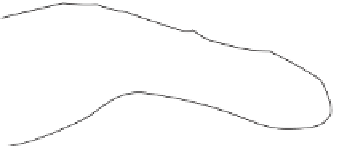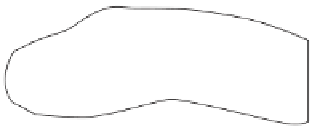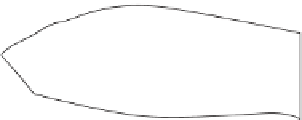Geoscience Reference
In-Depth Information
Figure 10.15
Two stages in continental
collision. The convergence of
two continents has almost
closed the intervening ocean
basin (a) leading to continental
collision, A-subduction, folding
and faulting (b). Ophiolite
nappes (brown stripe) lie along
the suture; key otherwise as
Crustal Shortening
Shrinking ocean basin
(a)
Collision Orogen
Suture
Folding and thrusting
of flysch and flakes
Folding and
thrusting
A-subduction
A-subduction
Partial melting and diapirism
(b)
effects at their conservative margin, or with oblique
subduction or spreading. This occurs at the plate bound-
ary itself or, through drag effects, in adjacent litho-
sphere. New Zealand is transected by active strike-slip
B-subduction at the Pacific/Indo-Australian plate bound-
ary. The San Andreas fault system of California, triggered
where the East Pacific Rise (mid-ocean ridge) comes
onshore, is moving San Francisco and Los Angeles slowly
together (
Plate 10.3
).
The Great Glen fault in Scotland
displaced what is now the Scottish north-west highland
zone 300 km south-west during the Palaeozoic. The many
oblique, as well as head-on, movements at convergent
plate boundaries determine that
accretionary tectonics
incorporate slivers and flakes of
suspect
or
displaced
terranes
, including ophiolites far removed from their sea-
floor origins.
character of major examples are explained in
Chapter 24.
Annual uplift rates of 10-20 mm yr
-1
may seem modest
but would amount to several thousand metres if sustained
for just 1 Ma. Modern Cenozoic orogens represent later
stages of the post-Pangaea supercontinental cycle and
many experience rapid uplift, stimulating vigorous
erosion as endogenetic and exogenetic forces converge
(
Figure 10.16
and
Plate 10.4
).
They are convincing
evidence that great tracts of Earth's highest mountain
ranges achieved their present altitude and appearance
only during the later Tertiary and Quaternary periods.
Older, tectonically quiet and more subdued orogens, such
as the Palaeozoic mountains of Appalachia-Scandinavia
(the Caledonian orogeny) and the Atlas, Urals and Tien
Shan (the Hercynian or Variscan orogeny), can still be
recognized in continental interiors, and remnants of
ancient Archaean orogens contribute now to stable
continental cratons, or shields.
Subduction processes absorb collision by converting
crustal shortening into thickening along a narrow front.
Occasionally, sustained thickening and isostatic uplift
elevate broad plateaux rather than narrow orogens. The
Orogens
Plate convergence creates major
orogens
or narrow,
linear
cordilleran mountain
systems - literally, 'chords' of
sub-parallel ranges and intervening basins reflecting
substantial crustal deformation. The origin and dynamic


































































































































































































































































